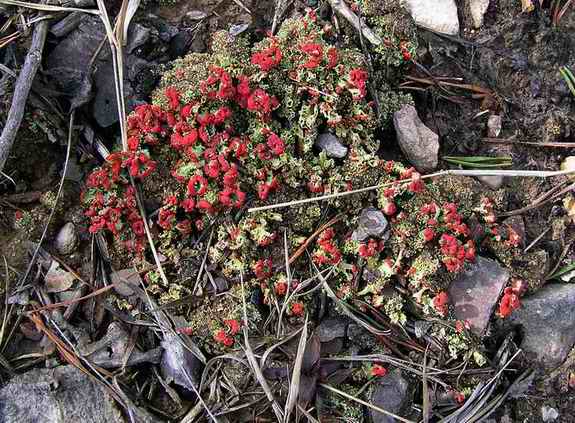|
Return to Hiker's Notebook Home Page Common Name: British Soldier Lichen, Matchstick moss- The stark contrast of the bright red at the tips of the branch-like appendages to the mossy gray-green of the support structure is reminiscent of the traditional uniforms of the soldiers of the British Army, the appellation "red coat" was a pejorative widely used in the colonies during the American Revolution. Lichen is derived from the Greek leichein which means "to lick," probably in reference to the tongue-like structure of many lichens.
Scientific Name: Cladonia cristatella - The generic name is from the Greek word kladon which means "sprout" in reference to the characteristic vegetative shrub-like appearance of the fungal body. The species name is from the Latin crista, "crest" and the diminutive suffix ella; literally the "small crest." This is to describe the tufted structure at the tips or crests of the appendages.
A lichen is a dual organism that consists of a fungus and an alga that live in mutualism, a type of symbiosis in which both constituents share the benefits of the association. The fungus is called the mycobiont and the alga is called the photobiont. The reason for the close mutual relationship is survival. Lichens occupy extremely adverse environmental habitats that range from isolated rock outcrops in the frigid rarefied atmosphere at elevations over 6,000 meters to the searing heat of the equatorial desert.
There are about 20,000 species of fungi that exist only as lichens, about 20 percent of the known fungi population. None are found without their symbiotic partner in the natural environment, though they can be produced in the laboratory when isolated under axenic conditions. The alga is thus key to the lichen's survival. However, the fungus is the dominant partner of the mutualistic association, comprising about 90 percent of the overall biomass. It forms the primary structure or thallus of the lichen and is responsible for anchoring it to a substrate and absorbing water and minerals from the environment for sustainment. Because of this primacy, the lichen is named for the fungus absent any reference to the algal partner.
Lichenized fungi are divided into five categories according to their basic morphology: crustose, foliose, fruticose, squalmulose and leprose. These correspond to crusty, leaf-like, shrubby, scale-like (squama is Latin for scale) and powdery. The British Soldier Lichen is of the fruticose category, as it has the appearance of a small shrub. The individual cylindrical upright branches are called podetia which provide support for the red apothecia, which are the spore bearing organs of the fungus. Each apothecium is an open cup that releases spores according to the appropriate environmental stimulation.
The photobiont organism of the British Soldier Lichen is Trebouxia erici, one of the green algae. Unlike their myriad mycobiont associates, 90 percent of all photobionts come from only three genera, Trebouxia, a unicellular green alga genus, Trentepohlia, a filamentous green alga and Nostoc, a cyanobacterium. Though the photobionts have the ability to exist in the natural environment without their fungal symbionts, they are rarely found; free-living populations of Trebouxia have never been found. This leads to the general conclusion that the algae and fungi of the lichen are totally dependent on their mutualism for survival.
The body or thallus of the lichen is divided into four distinct layers, three fungal and one algal. The top layer is called the upper cortex and consists of tightly packed fungal filaments called hyphae that protect the lichen from the environment and may be pigmented to shield from specific light spectra. The algal layer is just under the upper cortex and is permeated by the hyphae of the third layer (medulla) which is comprised of loosely woven hyphal threads. The lower cortex is the bottom layer with specialized structures called rhizines that attach to almost any substrate, including rocks.
The flow of nutrients between the mycobiont and the photobiont is the essence of the mutualistic relationship. The fungal symbionts have specialized structures called haustoria that penetrate the cells of the alga. In the photosynthetic process, T. erici produces a type of carbohydrate called ribitol. This is transported to the C. cristatella cell where it is turned into mannitol, a sugar alcohol widely found in fungi as a storage product. Because of the penetration of the algal cell by the fungus, the transport and conversion process occurs quite rapidly, often in under two minutes. It is also hypothesized that the alga provides vitamins to the fungus, notably biotin and thiamine. The role of the fungus in the relationship is not as well defined. It is highly efficient at absorbing water vapor from the air, so much so that at high humidity levels, the algae photosynthesize at nearly their maximum rate. The fungal component also synthesizes a number of unique organic compounds some of which are chelating agents that bind to metal atoms, thus providing a source of minerals to the alga. |
